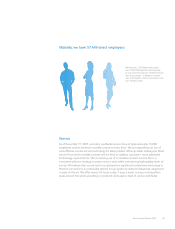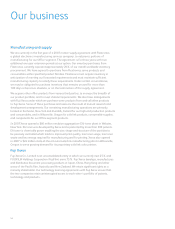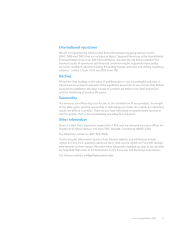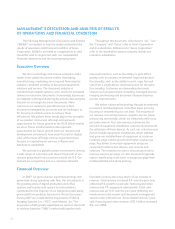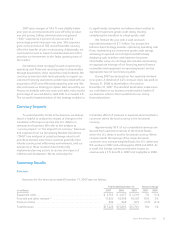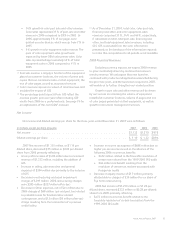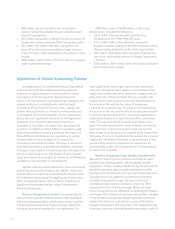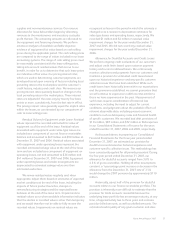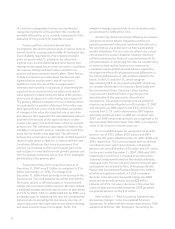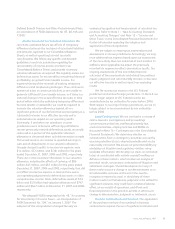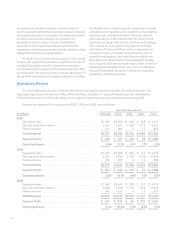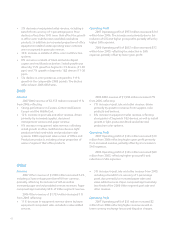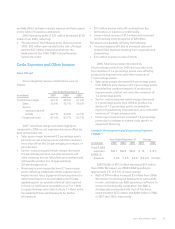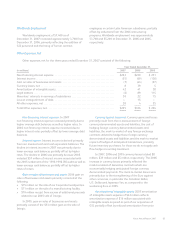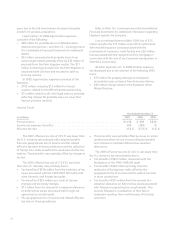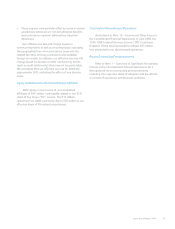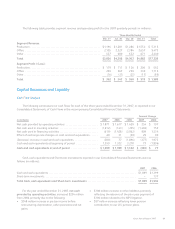Xerox 2007 Annual Report Download - page 61
Download and view the complete annual report
Please find page 61 of the 2007 Xerox annual report below. You can navigate through the pages in the report by either clicking on the pages listed below, or by using the keyword search tool below to find specific information within the annual report.Defined Benefit Pension and Other Postretirement Plans,
an amendment of FASB Statements No. 87, 88, 106 and
132(R).”
Income Taxes and Tax Valuation Allowances: We
record the estimated future tax effects of temporary
differences between the tax bases of assets and liabilities
and amounts reported in our Consolidated Balance
Sheets, as well as operating loss and tax credit
carryforwards. We follow very specific and detailed
guidelines in each tax jurisdiction regarding the
recoverability of any tax assets recorded in our
Consolidated Balance Sheets and provide necessary
valuation allowances as required. We regularly review our
deferred tax assets for recoverability considering historical
profitability, projected future taxable income, the
expected timing of the reversals of existing temporary
differences and tax planning strategies. If we continue to
operate at a loss in certain jurisdictions or are unable to
generate sufficient future taxable income, or if there is a
material change in the actual effective tax rates or time
period within which the underlying temporary differences
become taxable or deductible, we could be required to
increase the valuation allowance against all or a
significant portion of our deferred tax assets resulting in a
substantial increase in our effective tax rate and a
material adverse impact on our operating results.
Conversely, if and when our operations in some
jurisdictions were to become sufficiently profitable to
recover previously reserved deferred tax assets, we would
reduce all or a portion of the applicable valuation
allowance in the period when such determination is made.
This would result in an increase to reported earnings in
such period. Adjustments to our valuation allowance,
through charges/(credits) to income tax expense, were
$14 million, $12 million, and $(38) million for the years
ended December 31, 2007, 2006 and 2005, respectively.
There were other increases/(decreases) to our valuation
allowance, including the effects of currency, of $86
million, $45 million, and $61 million for the years ended
December 31, 2007, 2006 and 2005, respectively, that did
not affect income tax expense in total as there was a
corresponding adjustment to deferred tax assets or other
comprehensive income. Gross deferred tax assets of $3.6
billion and $3.9 billion had valuation allowances of $747
million and $647 million at December 31, 2007 and 2006,
respectively.
We adopted FASB Interpretation No. 48, “Accounting
for Uncertainty in Income Taxes – an Interpretation of
FASB Statement No. 109,” on January 1, 2007. The
adoption of this interpretation changed the way we
evaluated recognition and measurement of uncertain tax
positions. Refer to Note 1 – “New Accounting Standards
and Accounting Changes” and Note 15 – “Income and
Other Taxes” in the Consolidated Financial Statements for
further information regarding the adoption and
application of this interpretation.
We are subject to ongoing tax examinations and
assessments in various jurisdictions. Accordingly, we may
incur additional tax expense based upon our assessment
of the more-likely-than-not outcomes of such matters. In
addition, when applicable, we adjust the previously
recorded tax expense to reflect examination results. Our
ongoing assessments of the more-likely-than-not
outcomes of the examinations and related tax positions
require judgment and can materially increase or decrease
our effective tax rate as well as impact our operating
results.
We file income tax returns in the U.S. Federal
jurisdiction and various foreign jurisdictions. In the U.S. we
are no longer subject to U.S. Federal income tax
examinations by tax authorities for years before 2006.
With respect to our major foreign jurisdictions, we are no
longer subject to tax examinations by tax authorities
before 2000.
Legal Contingencies: We are involved in a variety of
claims, lawsuits, investigations and proceedings
concerning securities law, intellectual property law,
environmental law, employment law and ERISA, as
discussed in Note 16 – Contingencies in the Consolidated
Financial Statements. We determine whether an
estimated loss from a contingency should be accrued by
assessing whether a loss is deemed probable and can be
reasonably estimated. We assess our potential liability by
analyzing our litigation and regulatory matters using
available information. We develop our views on estimated
losses in consultation with outside counsel handling our
defense in these matters, which involves an analysis of
potential results, assuming a combination of litigation and
settlement strategies. Should developments in any of
these matters cause a change in our determination as to
an unfavorable outcome and result in the need to
recognize a material accrual, or should any of these
matters result in a final adverse judgment or be settled for
significant amounts, they could have a material adverse
effect on our results of operations, cash flows and
financial position in the period or periods in which such
change in determination, judgment or settlement occurs.
Business Combinations and Goodwill: The application
of the purchase method of accounting for business
combinations requires the use of significant estimates and
Xerox Annual Report 2007 59


